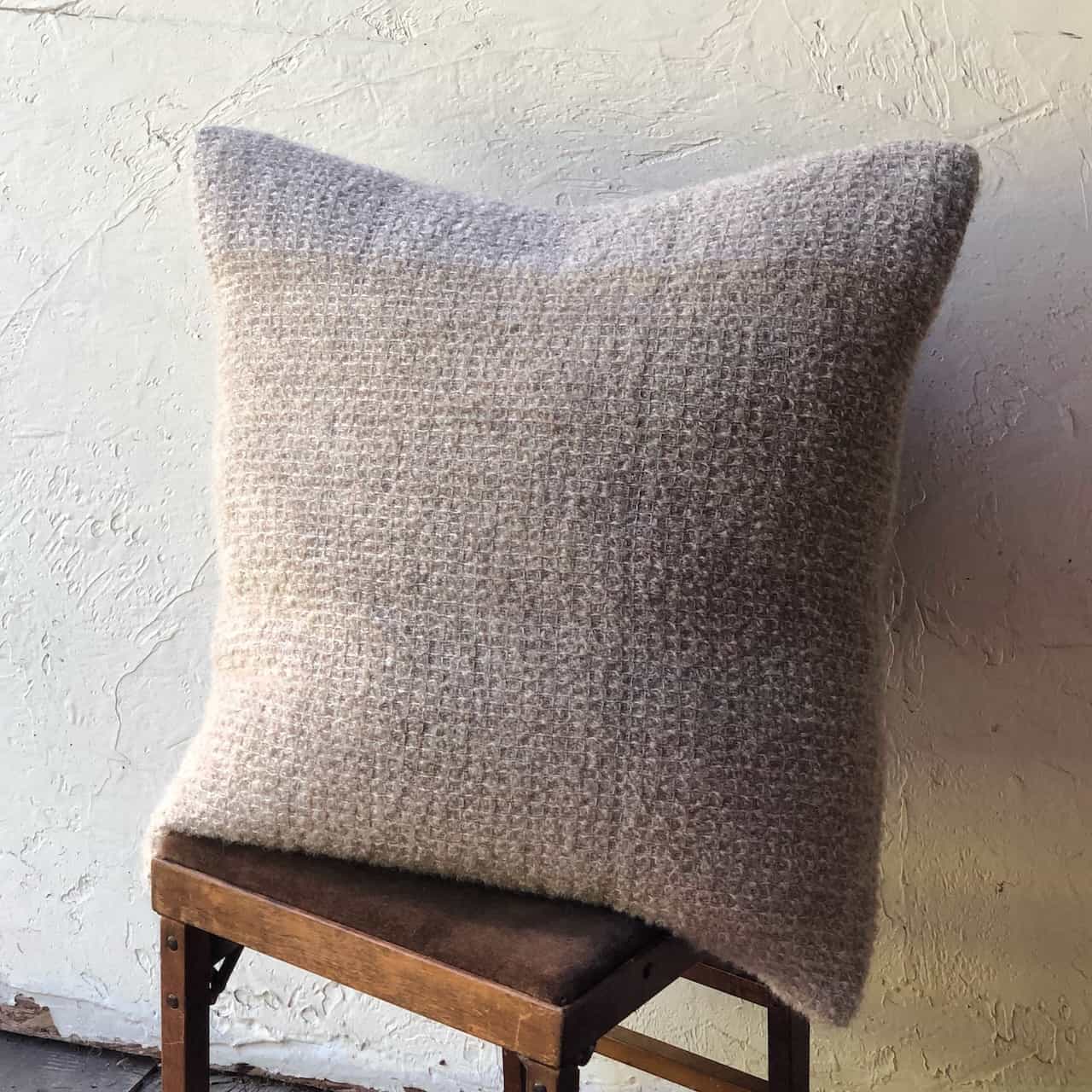
Lovely, Lucious, Linen
 Hello Weavers, I decided to write a post about linen after overhearing a group of weavers admiring a set of linen napkins, but agreeing with each other that linen is too scary to work with. Iq want to firmly respond “au contraire”! I think that the chatter among weavers about the difficulty and fussiness of linen is often misunderstood, and that if you learn to love linen, it will truly love you back. SO, some true facts about linen or Flax Facts (thank you Wikipedia):
Hello Weavers, I decided to write a post about linen after overhearing a group of weavers admiring a set of linen napkins, but agreeing with each other that linen is too scary to work with. Iq want to firmly respond “au contraire”! I think that the chatter among weavers about the difficulty and fussiness of linen is often misunderstood, and that if you learn to love linen, it will truly love you back. SO, some true facts about linen or Flax Facts (thank you Wikipedia):
- Linen is made from flax fiber and the word comes from a Germanic word and cognate to the latin word “linum” which means flax.
- Linen is one of the oldest fibers “The discovery of dyed flax fibers in a cave in Southeastern Europe (present-day Georgia) dated to 36,000 years ago suggests that ancient people used wild flax fibers to create linen-like fabrics from an early date.”
- Flax is a bast fiber (meaning the fiber comes from the stem of the plant) and is a much more sustainable plant than cotton, It can be grown using considerably less water and fertilizer.
- Flax is strong, very absorbent and quick drying and has been said to be anti-bacterial and hypo-allergenic.
- There are a variety of linen yarns available. “Line” linen is spun from the long staple fibers and is smoother and less hairy. “Tow” linen is spun from the shorter fibers that are left behind after hackling. It is hairier and more rustic than line linen. “Wet-spun” linen is spun using water and is also smoother and less hairy than “dry-spun” linen. There are wonderful blends like cottolin that are as easy to work with as cotton. Just be aware that most cottolin is made from “cottonized” linen, which means that the linen fiber has been chopped up to match the cotton staple length before it is spun. I love cottolin for its absorbancy and slightly rustic look, but it will not give you what I call the “linen flop” which is the ineffable hand/drape of pure linen. There are a few blends of cotton and linen that don’t cottonize the linen fiber. One is Gist “Italian Cotton Linen” which is a loosely spun cotton core with a very fine linen binder. That yarn has a delightful, slightly slubby texture and a great drape.
- Most linen used today comes from Northern Europe.
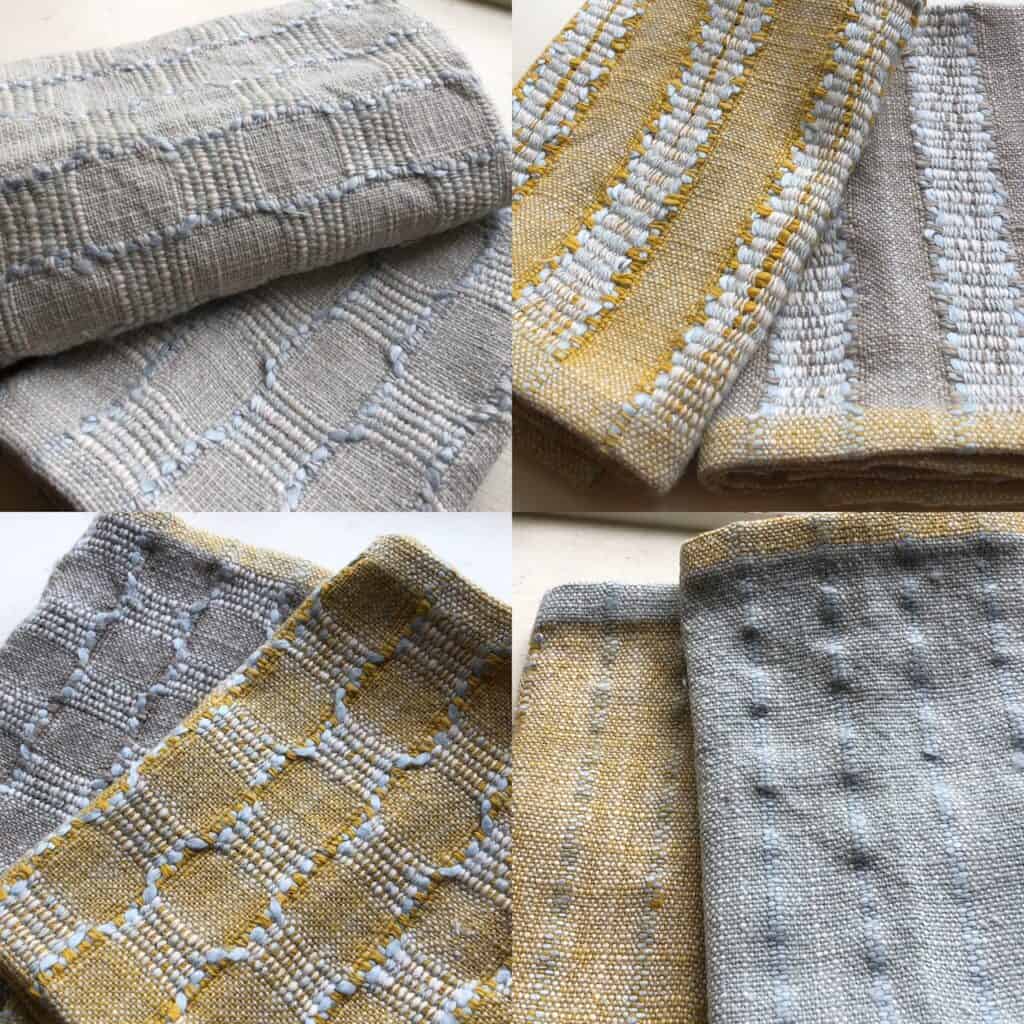
Napkins using Gist Cotton Linen along with accents of heavy linen knitting yarn.
There are also some untrue facts (or arguable facts) about linen that we need to think about:
- Linen can’t be woven on a jack loom. Yes, it can – I do it all the time. Yes, linen is inelastic and doesn’t love abrasion (who does?), and the up and down action of countermarch/counterbalance looms along with string or texsolv heddles can be gentler, but if you work on a jack loom – fear not!
- Linen is a scary, hard fiber to work with. No, it isn’t. First-time linen weavers simply need to choose their linen wisely. I think that a lot of the falderal (soak your bobbins, paint your warp with flax-seed sizing, use a humidifier, etc.) that you hear whispered at guild meetings comes from weavers working with specific types of linen, i.e. very fine singles, handspun, tow singles, etc.
- Linen wrinkles too easily. Well yes, linen does wrinkle. I always finish my woven linens by hand for the first wash and wash in the machine for subsequent washings. This is because my front loader spins very vigorously, and I mistakenly finished a set of linen towels in the washer for their first wash and got some permanent creases that I cannot iron out. Hand washing for the first wash seems to solve this problem. I also to hang all my household linens to dry. This is better for the longevity of the fabric, but also solves the ironing problem. I don’t have a mangle, so I use the linen setting on my iron when I really want to make my linens shine and drape gloriously.
- Linen is expensive. Again, yes it can be, but when thinking about the time investment that goes into handweaving, I always think that using the best materials I can afford is a better strategy than spending days/weeks/ months weaving something in an inferior yarn. Linen just gets better with time and use.
- Linen can’t be woven on a rigid heddle. Yes, it can. It is true that linen doesn’t love the “only one set of threads getting stretched” environment of the rigid heddle, but if you warp with the heddle raised, those threads are already being made longer in the warping, so they behave. Is there some drooping? Yes, but once you know nothing bad will come of it, you simply learn to throw your shuttle with care and all is well.
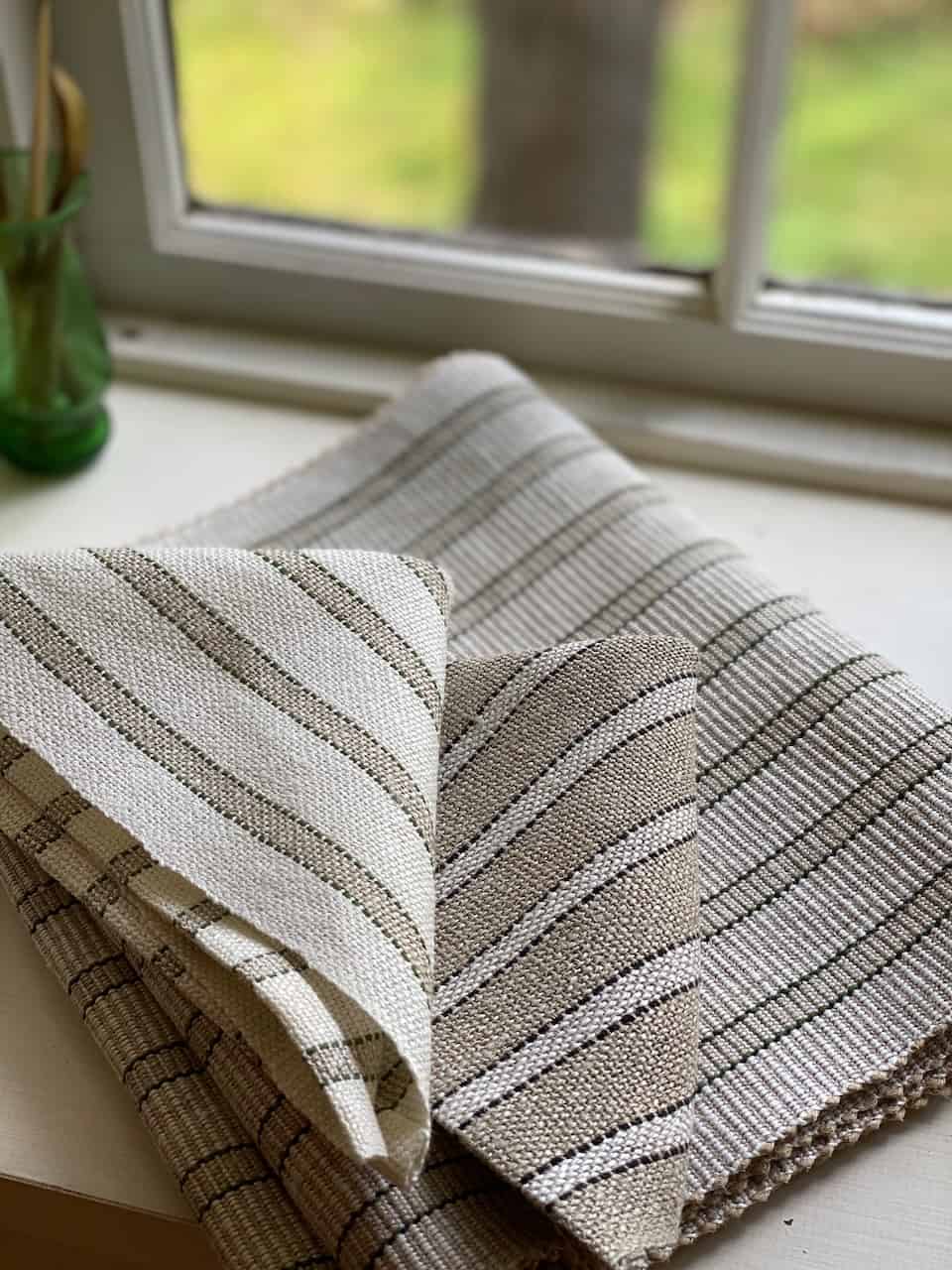
Napkins and rep runner in 30/3 Linen from Henry’s Attic.
And here are some tips from the experts with the caveat “not to bleed until your shot” to quote Amy Somerstein, fab weaver and hilarious student. While knowing about your fiber, listening when it “talks” and having some tips and tricks up your sleeve is always a good idea, don’t pull out the hacks, tips, etc until/unless you need them.
- Linen loves humidity, so keep your loom away from heater/direct sunlight that might blast it.
- Tom Knisely likes to dip his fingers in water when winding linen bobbins. He says that it makes the weft more flexible at the selvedges. You must use the bobbins right away and not wind too much ahead of use.
- Ton Knisely also likes to lash linen warps on for even tensioning, though Peggy Osterkamp claims that lightly spritzing your tie-on knots immediately before weaving will even out any problems. And I like (though no expert!) like to tie on in 1/2″ bouts rather than my usual 1″ bouts. Of course all these tips assume that best practices re winding/beaming/tying-on are a given.
- I like to weave fine linen with a little less tension than I usually use on my jack loom. I usually go hard!
- A temple can really help avoid abrasion at the selvedges, especially for weaves other than plain weave which tends to stay pretty flat.
- Pick yarn that will make your adventures into linen weaving rewarding. I have woven with mill-end linen singles, Bockens 28/2, 16/1, 16/2 and 8/1 tow, Henry’s Attic 40/2 and 30/3 linen, Gist Cotton Linen and 18/3 linen, Silk City Linen 14, and Euroflax 14/2, 30/2 and 16/1, and have only had issues when I sett the 40/2 too tightly or tried to use 8/1 in the warp as a new weaver. I admit that I haven’t ventured into the ultrafine world of singles linen used as warp, and if I did, I might pre-deploy the flaxseed dressing, humidifier, countermarche loom, etc. But that will be a tale for later. In the mean time, there is a whole world of weaving to be done with yarns that need no pampering and will give you wonderful results. Here I will insert a shameless plug for a few pattern from the Plainweave Etsy store:
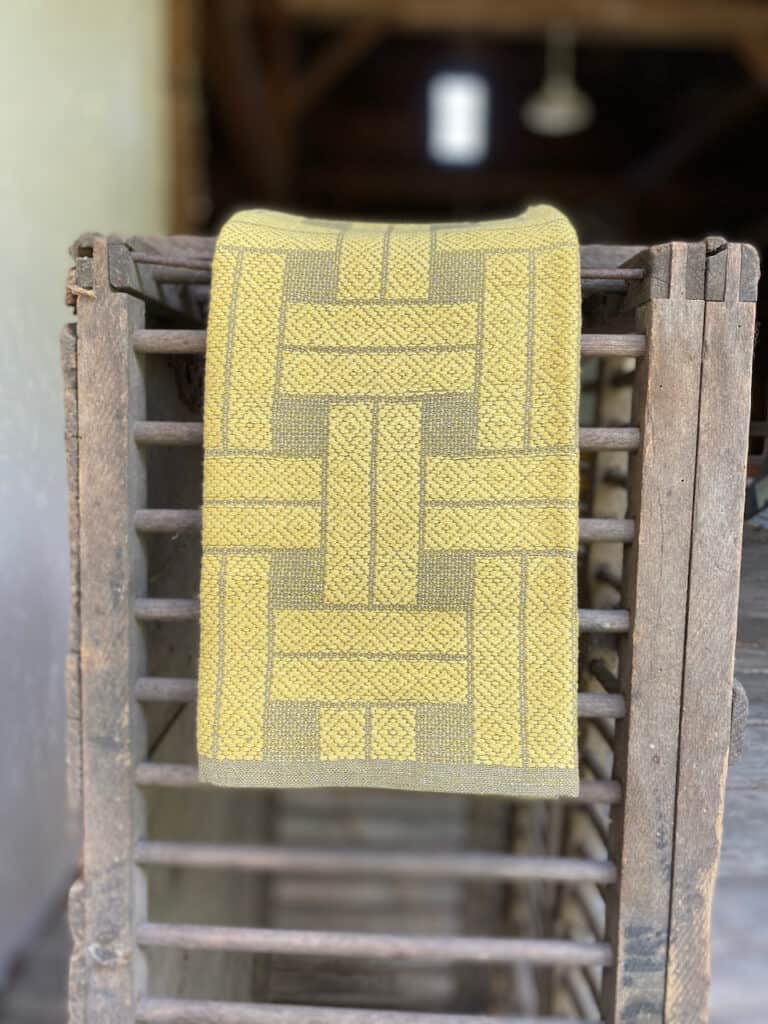
Heavy Meta Towels in 2 weights of the easy-to-work-with, super dreamy and sustainably-grown Euroflax Linen from Lofty Fiber.

Ellie’s Napkins designed and woven by Véronique Perrot in 30/2 linen from Lofty Fiber.
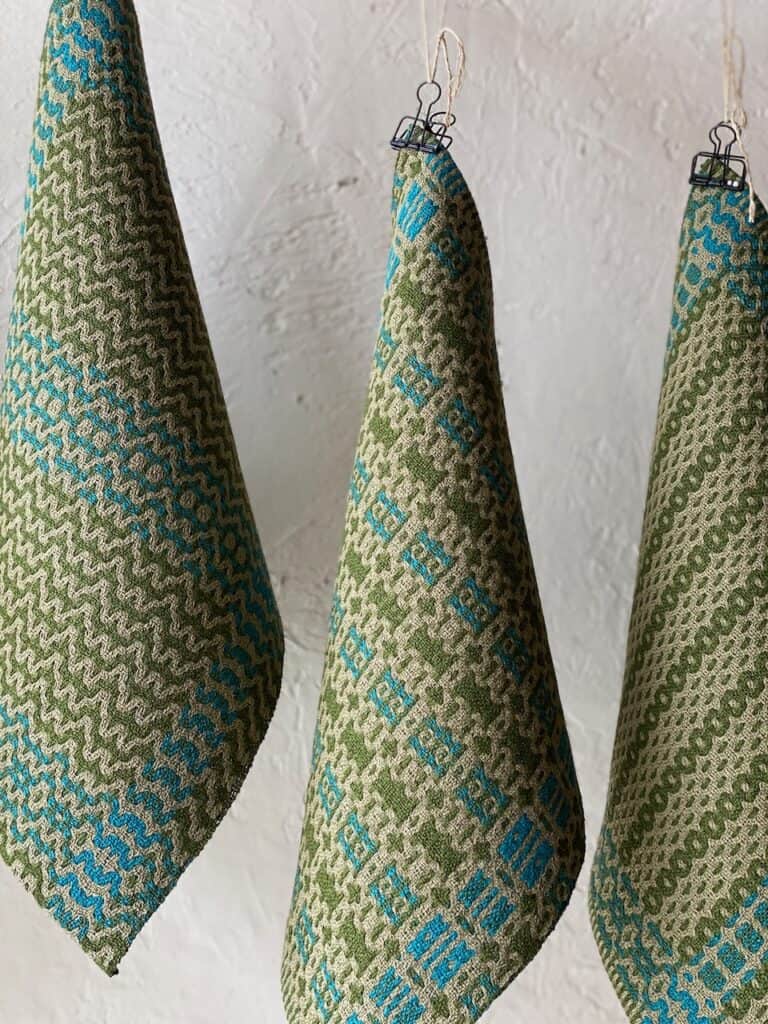
Flexi-flax placemats and napkins in deflected double weave using Euroflax linen.
And coming soon
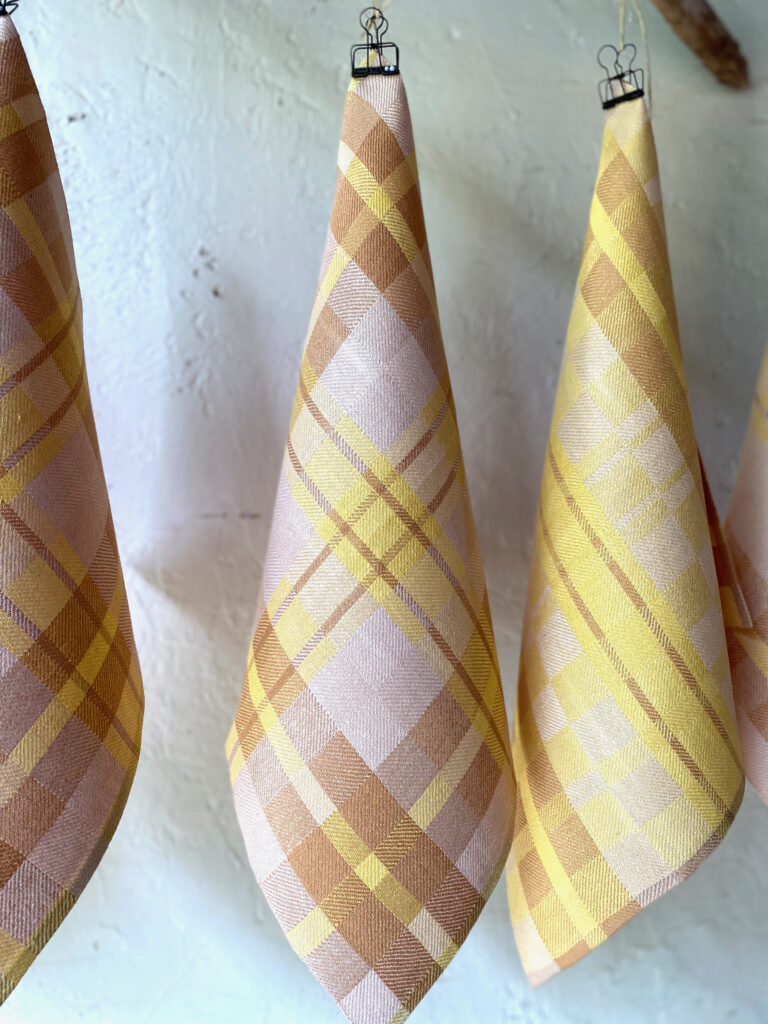
Swellegant Linen napkins in 30/2 Euroflax linen. Available on ETSY
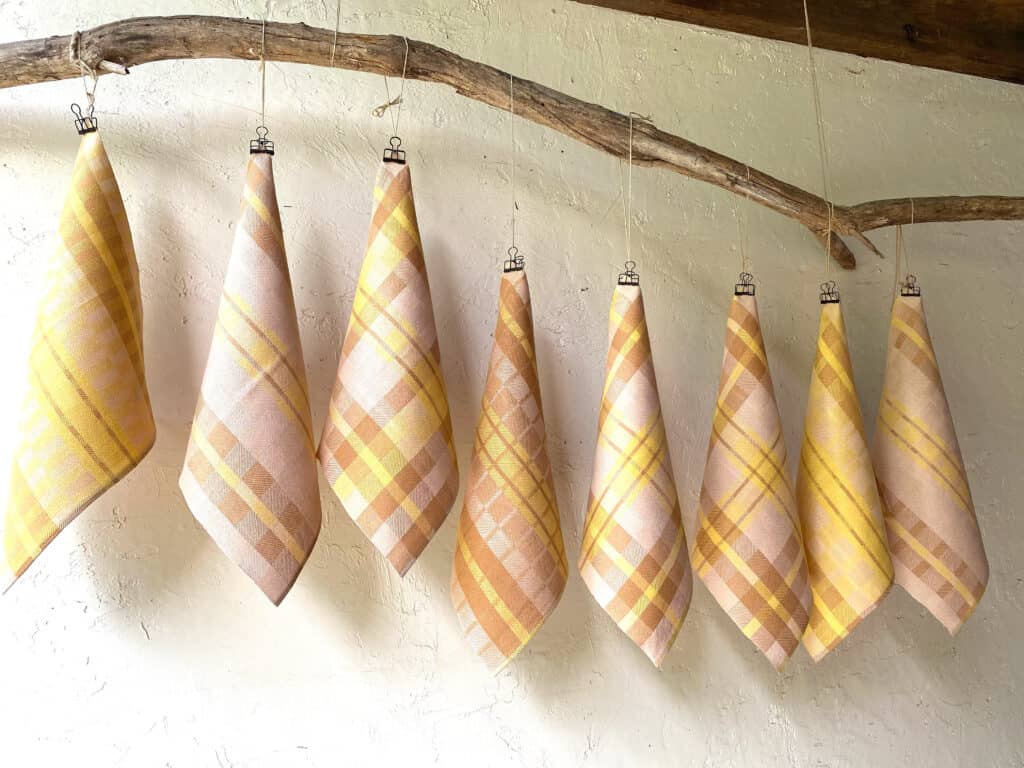

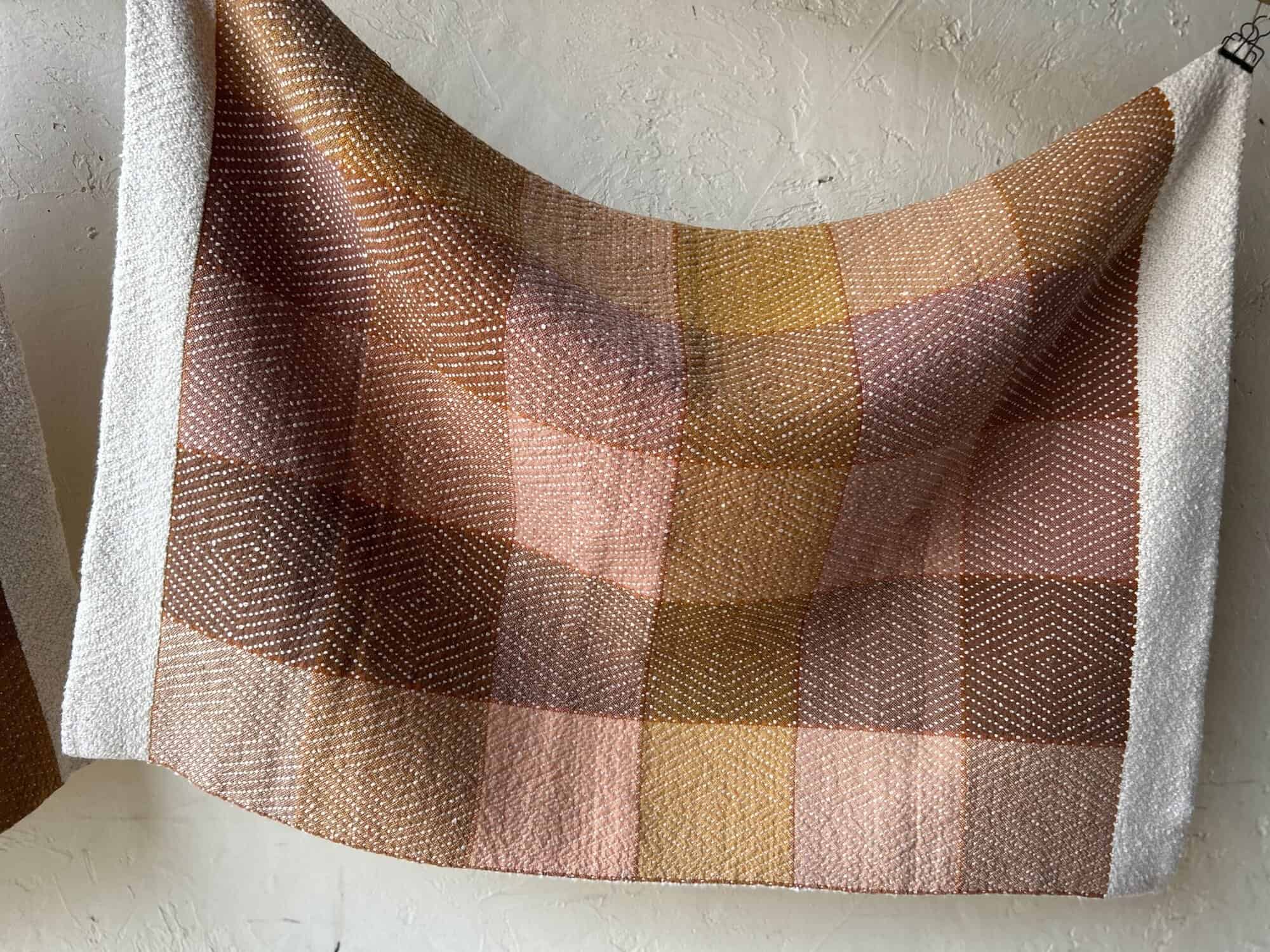
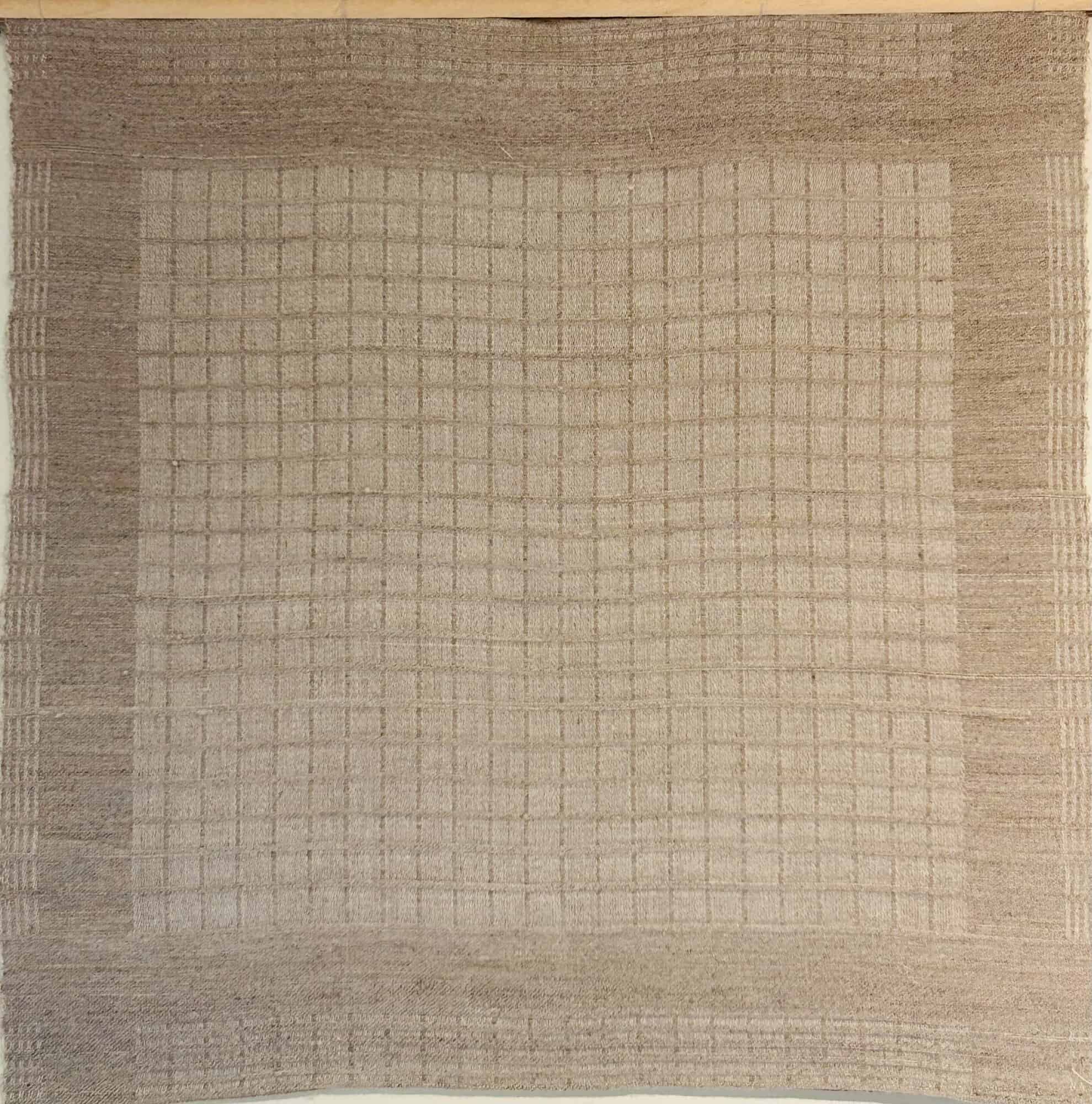
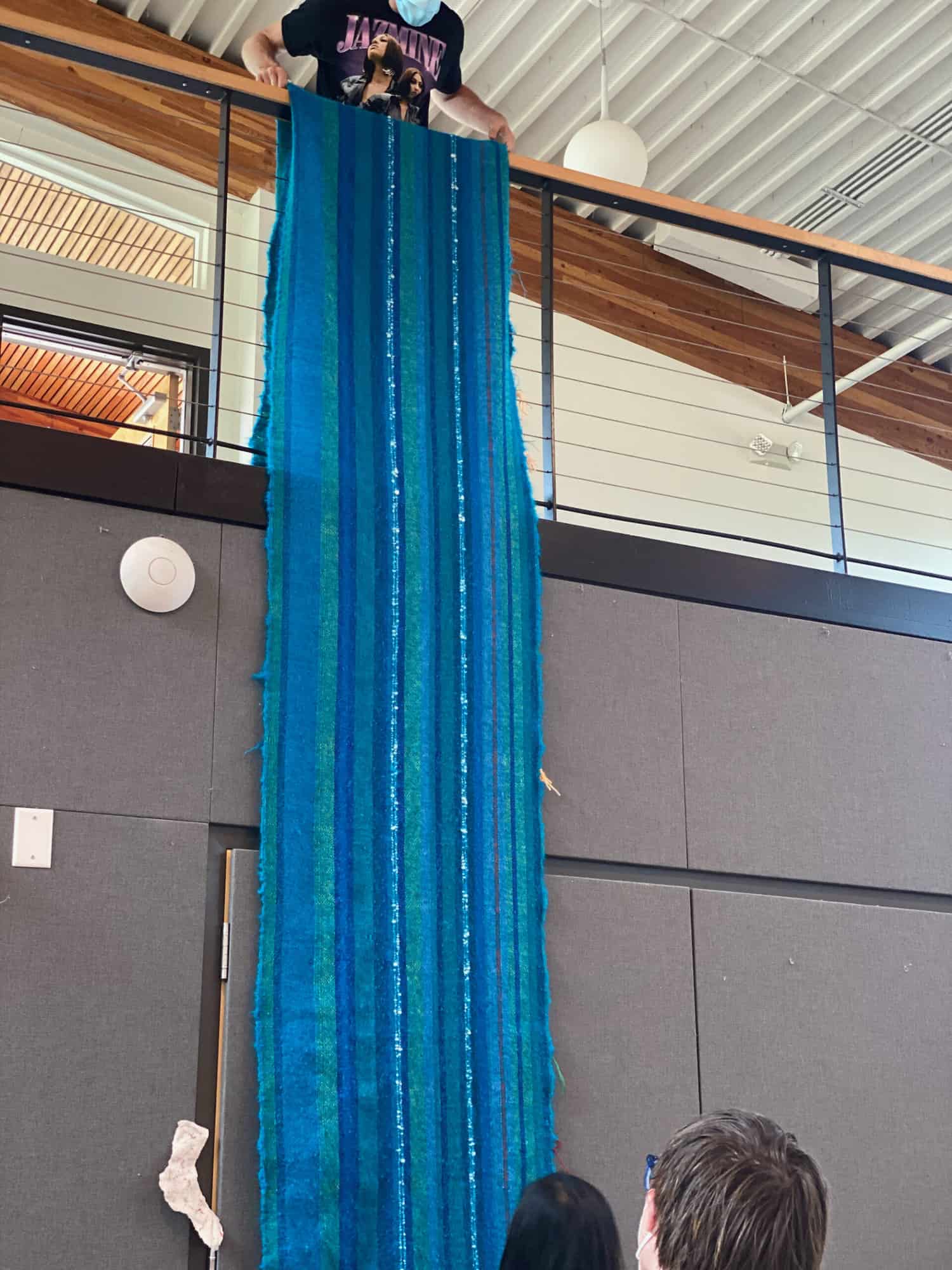
Bettie
Ooh, ooh, oooh that scarf at the top is exquisite!! Thanks for the confidence-building truth bomb & demystifying the best of the bast! xo
Elisabeth Hill
❤️Best of bast!
Diane Howes
Wear your wrinkles proudly! I think you should add bumper stickers to your Etsy Shop😁
Elisabeth Hill
Yes!!! Garment as well as other😂.
marlene toerien
Hi Elisabeth, thank you for the tips of weaving with linen.I think my German Weaving teacher way back in 1977 wanted to test my staying power as I was the only complete newby in the class. I was a week late for the class so she made me a mohair warp first which break so much that I couldn’t weave any samples and then she grabbed two cones of left over yarn, wound a warp of 60 threads wound it on, and then realised her mistake she grabbed linen instead of the more cheaper cotton left over covens. I immediately fell in love with linen there and then.
Elisabeth Hill
What a start Marlene! Great story and so glad to hear from you.
Tory
still working up the courage, but just read (online VavMagasinet) one weaver’s suggestion to dampen your tie on knots to keep them from slipping. Makes sense!! Some day I will actually weave with linen 😉
Elisabeth Hill
Hey Tory,
It is the perfect weather for linen weaving. While we suffer, linen rejoices:)))
lexy cann
Hi,
Thank you for the information on linen! I’m just about to start my first project using a linen warp and a jack loom, so I really appreciate the confidence building information.
I also love the scarf at the top of the page–could you offer more information on it? I would happily buy the pattern or kit if available.
Again, thank you!
Elisabeth Hill
Hi Lexy, Thanks for the comment, and good for you for taking a dive into linen. It is a rewarding journey for sure. I don’t have a pattern written for the scarf pictured. It is a triple weave experiment. Woven as a tube with un-woven weft threads floating inside the tube and interlaced at the borders. I wouldn’t recommend it as a “first” linen project though its not hard to weave. I will add it to my list of possible projects to develop. Let me know how the linen goes and happy weaving!